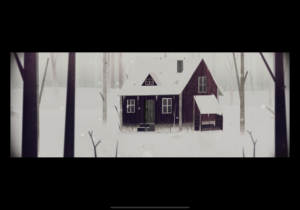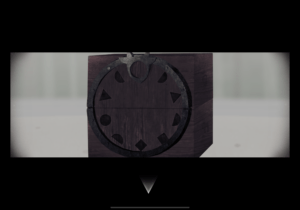
Game name: Year Walk
Creator: Simogo
Platform: iOS, OS X, Microsoft Windows, Wii U (Played on iOS)
For this assignment I decided to play Year Walk. Last week I played Sailor’s Dream – another walking simulation game, and I found Year Walk very similar to it. Therefore, it was easier to explore and analyze the game.
While playing and analyzing this game I learned that the year walk is an archaic form of divination in Swedish folklore, in which a person would deprive themselves of sleep and food in a dark room for 24 hours to then venture through the woods towards the local parish. Therefore, I think Year Walk is a wonderful folklore adaption that makes good use of modern technology, effortlessly integrating two worlds across time. The story takes place in late 19th-century Sweden and is about two people who meet secretly and fall in love. The player character goes on a vision quest to find out more about what will happen to them in the future. The mystery is kept in solving the riddle of what happened to the girl the guy had fallen in love with

Year Walk is a single player, first-person game that takes place on a 2D plane. Most of the action happens on the main screen. The camera is always pointed north, and you can look around by panning east and west. Defined paths make it possible to move between areas from north to south, and environmental clues show where the path goes. A small white arrow pointing up or down appears at the top and bottom of the screen to show where you can go. So the main mechanics of the game is walking back and forth and zooming across a side-scrolling environment.
Those strolls have a purpose: they familiarize the player with the village. Thanks to the game’s great sound design, they help you feel as if you are really there. This game shouldn’t be played in a rush because it is a time for contemplation and requires thoughtful approach.

The types of fun that I encountered during the play are exploration and challenge. Game encourages you to explore the environment and find secrets of the future. This game is based on the Embedded Narrative. As players move through the game they reformulate their mental maps of the narrative action and story space. In comparison to Sailor’s Dream, I found this game more structured and controlled by the system itself. A player has certain directions to go and does not have choice to explore beyond. The game does provide helpful hints to keep you going. However, I would prefer to have a choice of going beyond and explore other parts of the game whenever I want like in the Sailor’s Dream.

One of the main things about this game is stunning aesthetics that give a great sense of pleasure especially when you are playing it on iPad. Snowy landscapes combine with gorgeously fading color palettes to create an unusual aesthetic reminiscent of a ghostly fairytale. Another important thing is the excellent sound design that plays significant role in solving some puzzles.



